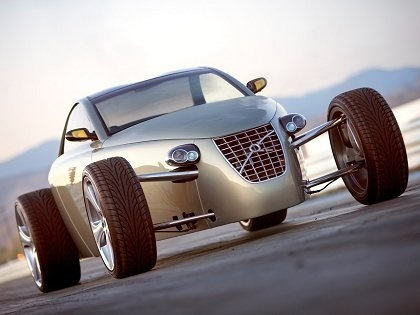2002 Volkswagen Magellan Concept
- Story Cars

- Apr 1, 2024
- 2 min read
The 2002 Volkswagen Magellan Concept, named after the Portuguese navigator Magellan, showcased a W8 engine with a power output of 202 kW / 275 bhp. Equipped with four-wheel drive and pneumatic suspension featuring active hydraulic shock absorption, the Magellan concept aimed to combine the emotional appeal of modern SUVs, the versatility of MPVs, and the agility of an estate car.
The Volkswagen Design-Center Europe in Sitges near Barcelona spearheaded the development of the Magellan, aiming to blend the off-road capabilities of SUVs with the harmonious integration of estate car features and the clarity of MPVs. The dimensions of the Magellan, measuring 4,685 mm in length and 1,860 mm in width, align with those of an SUV, while its height of 1,620 mm establishes a new category, positioning it lower than an SUV or an MPV but higher than an estate car.
Emphasizing its off-road prowess, the Magellan features bold wheel arches, 19-inch six-spoke wheels with 245 Michelin tires, ample ground clearance, short overhangs, and a relatively long bonnet. Integrated estate car elements include a steeply raked windscreen and a low silhouette reminiscent of sporty estate cars, contributing to the crossover principle. The MPV aspects manifest in the car's width, height, clarity, and interior design.
While Volkswagen historically epitomized the burgher's car – unpretentious, unsophisticated, and inexpensive – shifting market trends prompted the company to explore new directions. With the rapid growth of the SUV market and a desire to regain popularity in the Americas, Volkswagen set its sights on the SUV segment, introducing models like the Tuareg. Additionally, the surge in hybrid vehicles with a sporty edge prompted Volkswagen to position the Magellan as a "sports car," capitalizing on emerging market trends.
Named after the pioneering Portuguese navigator Magellan, who conducted the world's first circumnavigation in the 14th century, the Magellan concept mirrors its namesake's adventurous spirit. Like Magellan's journey, Volkswagen's SUV endeavors faced obstacles before finding support, with the Austrian company Steyr-Puch playing a crucial role in the development of all-terrain vehicles like the Gelandewagen.
The Magellan concept embodies a hybrid approach, borrowing all-wheel drive and high-tech design from SUVs and a multi-variant interior from station wagons and minivans. Spiritually akin to Audi Allroad, the Magellan incorporates components and assemblies from various Volkswagen models, including the Phaeton, Tuareg, and Audi A8.
Powered by a 275-horsepower W8 engine and featuring permanent all-wheel drive and air suspension with active damping, the Magellan offers dynamic performance in a compact package. With dimensions of 4,685x1,860x1,620 mm and 19-inch tires, the Magellan is smaller than previous Volkswagen models like the Microbus but comparable to the Allroad.
Externally, the Magellan embodies minimalism, while the interior adopts a diametrically opposite approach with an abundance of hi-tech features. Toggle switches, levers, and handles gleam with an aluminized coating, competing for the driver's attention despite efforts to visually separate primary functions from secondary ones.
The interior accommodates six occupants, with seats mounted on monorail sleds for a floating effect. The third-row seats can be recessed into the floor to maximize luggage space, reflecting a two-tone scheme with cold, lifeless colors reminiscent of yearning for distant shores.
Volkswagen representatives hinted at the possibility of production for the Magellan concept, suggesting a potential appearance in dealer showrooms within two years, although pricing details remained undisclosed.
Source & Images: Volkswagen AG

































Comments